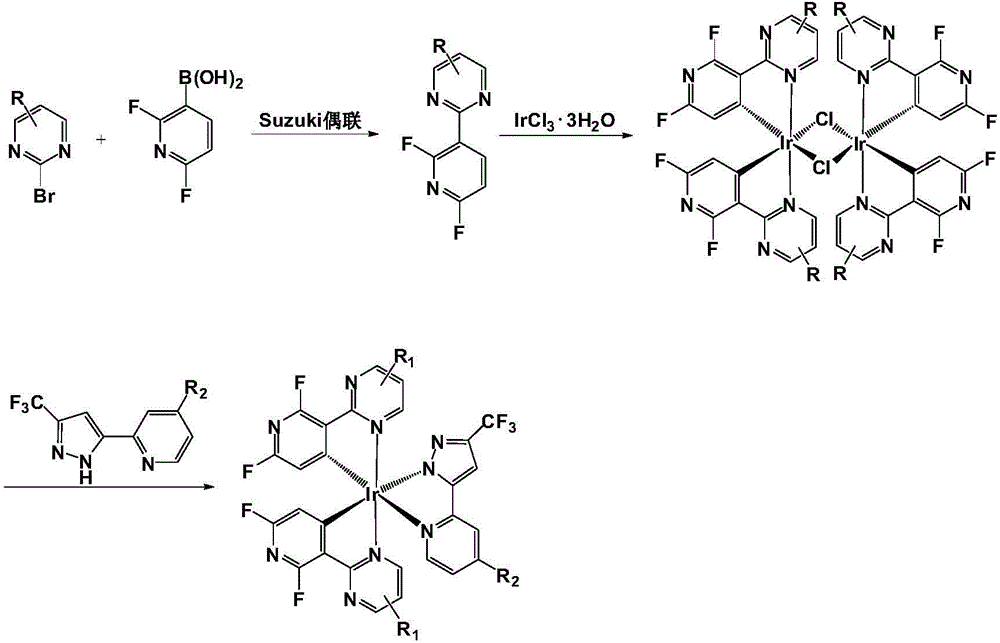Organic electroluminescent material, preparation method of organic electroluminescent material and organic electroluminescent device
An electroluminescence and electromechanical technology, applied in the field of phosphorescent materials, can solve the problems of luminescent color purity, luminous efficiency device efficiency attenuation bottleneck, HOMO energy level drop, and luminescent wavelength blue shift of blue-light phosphorescent materials.
- Summary
- Abstract
- Description
- Claims
- Application Information
AI Technical Summary
Problems solved by technology
Method used
Image
Examples
preparation example Construction
[0047] The preparation process of the organic electroluminescent material (P) of the present invention is roughly divided into the following steps:
[0048] (1) Synthesize compound C through Suzuki coupling reaction of compound E and compound F; wherein, compound F is 2,6-difluoropyridine-3-boronic acid, and the structural formulas of compound E and compound C are as follows:
[0049] Compound E is Compound C is Among them, R 1 is a hydrogen atom, C 1~20 straight chain alkyl, C 1~20 Branched chain alkyl, C 1~20 Linear alkoxy or C 1~20 branched chain alkoxy.
[0050] (2) Reaction of compound C prepared in step (1) with compound D to generate a chlorine-bridged dimer, namely compound A. Wherein, compound D is trihydrate iridium trichloride IrCl 3 ·3H 2 O. The structural formula of compound A is as follows:
[0051]
[0052] (3) Compound A prepared in step (2) is used as a ring metal ligand, and compound B is used as an auxiliary ligand source to react compound A ...
Embodiment 1
[0057] The organic electroluminescent material (P) disclosed in this example is the complex bis(2-(2′,6′-difluoropyridin-3′-yl)pyrimidine-N,C 4 ') (3-trifluoromethyl-5-(pyridine-2'-yl) pyrazole) iridium, its structural formula is as follows:
[0058]
[0059] It is prepared by the following steps:
[0060] (1) Synthesis of 2-(2′,6′-difluoropyridin-3′-yl)pyrimidine
[0061] The synthetic reaction formula of 2-(2',6'-difluoropyridin-3'-yl)pyrimidine is as follows:
[0062]
[0063] The specific steps are: under nitrogen atmosphere, 1.59g (10mmol) 2-bromopyrimidine, 1.91g (12mmol) 2,6-difluoropyridine-3-boronic acid and 0.58g (0.5mmol) tetrakis (triphenylphosphine) palladium Dissolve in 40ml of toluene, then add dropwise 20ml of a solution containing 2.76g (20mmol) of potassium carbonate to the reaction system. Heat to 100°C and stir the reaction for 8h. After the reaction solution was cooled to room temperature, it was extracted with dichloromethane, separated, washed ...
Embodiment 2
[0077] The organic electroluminescent material disclosed in this example is the complex bis(2-(2′,6′-difluoropyridin-3′-yl)pyrimidine-N,C 4 ') (3-trifluoromethyl-5-(4'-tert-butylpyridin-2'-yl) pyrazole) iridium, its structural formula is as follows:
[0078]
[0079] It is prepared by the following steps:
[0080] (1) Synthesis of 2-(2′,6′-difluoropyridin-3′-yl)pyrimidine
[0081] The reaction formula for the synthesis of 2-(2',6'-difluoropyridin-3'-yl)pyrimidine is as follows:
[0082]
[0083] The specific steps are: under nitrogen atmosphere, 1.59g (10mmol) 2-bromopyrimidine, 1.91g (12mmol) 2,6-difluoropyridine-3-boronic acid and 0.58g (0.5mmol) tetrakis (triphenylphosphine) Palladium was dissolved in 40ml of toluene, and then 20ml of a solution containing 2.76g (20mmol) of potassium carbonate was added dropwise to the reaction system. Heat to 100°C and stir the reaction for 8h. After the reaction solution was cooled to room temperature, it was extracted with dichlo...
PUM
| Property | Measurement | Unit |
|---|---|---|
| thickness | aaaaa | aaaaa |
| thickness | aaaaa | aaaaa |
| thickness | aaaaa | aaaaa |
Abstract
Description
Claims
Application Information
 Login to View More
Login to View More - R&D
- Intellectual Property
- Life Sciences
- Materials
- Tech Scout
- Unparalleled Data Quality
- Higher Quality Content
- 60% Fewer Hallucinations
Browse by: Latest US Patents, China's latest patents, Technical Efficacy Thesaurus, Application Domain, Technology Topic, Popular Technical Reports.
© 2025 PatSnap. All rights reserved.Legal|Privacy policy|Modern Slavery Act Transparency Statement|Sitemap|About US| Contact US: help@patsnap.com



